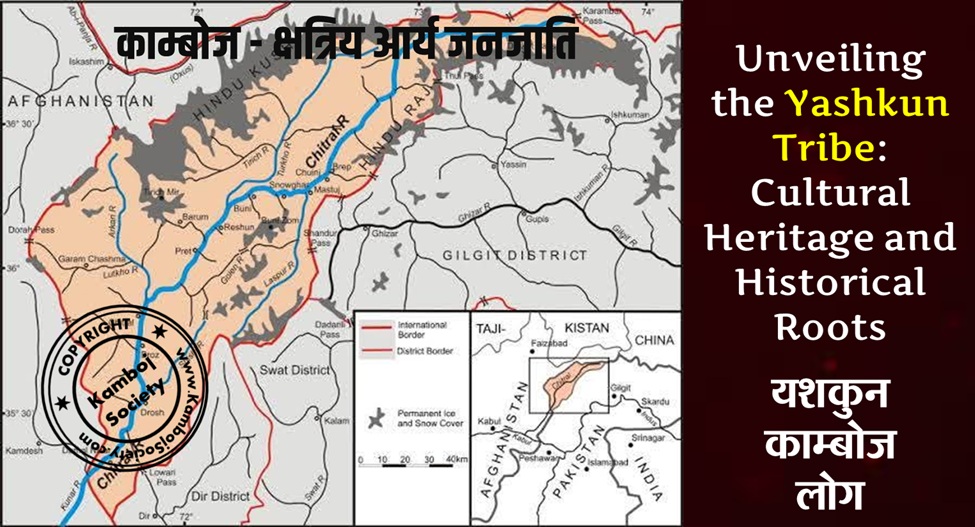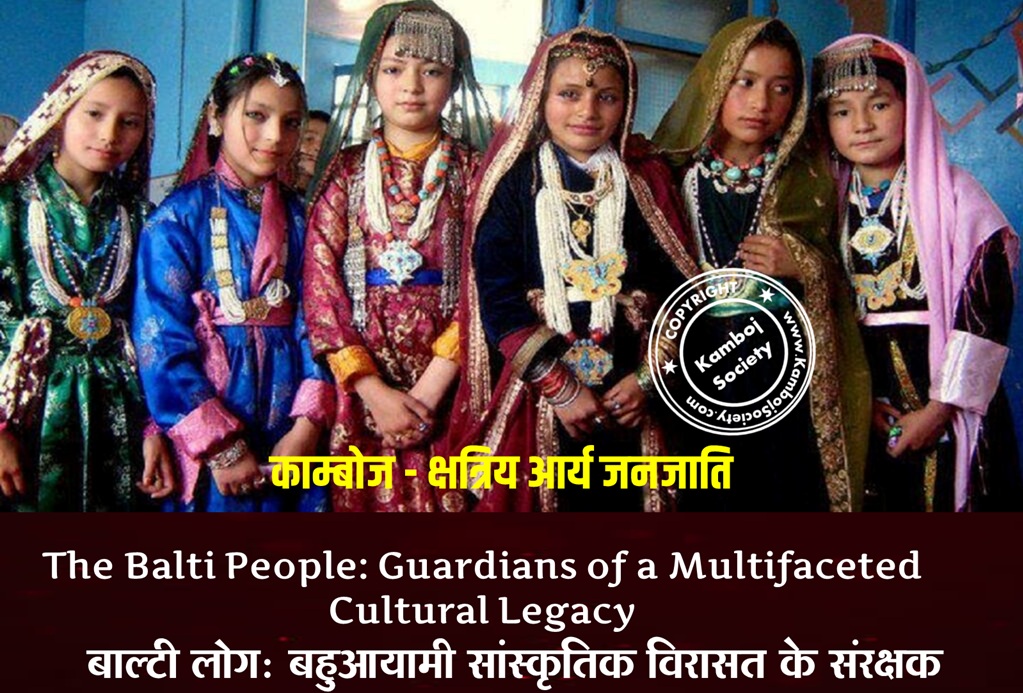A third branch of these Central Asian Kambojas seems to have migrated eastwards along the Himalayan foothills, hence their notice in the chronicles of Tibet (Kam-po-ji/Kam-po-ce) and Nepal (Kambojadesa). Fifth century CE [[Brahma Purana]] (53/16) mentions Kambojas with Pragjyotisas and Tamraliptikas. Sasanavamsa (P.T.S., pp 64-65, 83 etc) also attests the Kambojas in/around Burma. They were probably a section of those Kambojas who figure in history of Bengal. They had made an unsuccessful bid to conquer Gauda during the reign of king Devapala. A latter attempt of Kambojas was crowned with success and they deprived the Palas of the suzerainty over Gauda and set up one of their chiefs as king (History of India, p 399, Dr V. A. Smith)
Rajyapala, Narayanapala, Nayapala, Dharamapala and Gaudapati, also known as Kunjarghatavarshayan, are the known Kamboja kings who ruled in north-east Bengal. Kamboja rule in north-east Bengal is attested from Dinajpore Pillar Inscription as well as from Irda Tamrapatra inscriptio found in Irda, District Balasor, [[Orissa]], in 1931 (Edited/published by Dr N. G. Majumdar, 1934).
Irda Tamrapatra was found in Irda, Balasore (Orissa) in 1930 and was edited in 1934 by Dr N. G. Majumdar (E.I. Vol XXII., 1934, pp 150-58). Irda Tamrapatra describe generation after generation of kAmbojavaMshatilaka kings of Irda Tamra Patra. Following are the WELL-KNOWN KAMBOJA KINGS of Bengal referenced in the Irda Tamrapara [Provided the Pala Dynasty of Bengal and Pala Kamboja Dynasty of Bengal are two Separate Dynasties*]. Note the long Imperial titles which these Kamboja kings Rajyapala and Nayapala had assumed for themselves.
These were the Kamboja Kings of Bengal:| Rajyapala Kamboja | |
| Nayapaladeva Kamboja | |
| Narayanapala Kamboja | |
| Dharampala Kamboja | |
| JaganNath Kamboja | |
| Kunjarghatavershayan |
RAjyapAla Kamboja
NaYapAladeva Kamboja
NArAYaNapAla Kamboja
In fact, North and East Bengal saw the rise of the kAmboja kings centered at priYaGgu, which is still unidentified. It is not clear where they came from. The confusing part is there is a parameshvara paramabhaTTAraka mahArAjAdhirAja naYapAladeva, brother of previous king nArAYaNapAla, son of kAmbojavaMshatilaka paramasaugata mahArAjAdhirAja parameshvara paramabhaTTAraka rAjyapAla and his wife bhAgyadevI. Because of the coincidence in name, it is conjectured by some that the pAla rAjyapAla's mother was a kAmboja princess, and these kAmboja rulers are just a branch of the pAla dynasty. On the other hand, they may be the kambojas from north west India from where the pAlas used to get their horses, the tibetans, or the koca tribe (the related tribe mleca may be the origin of the term mleccha). There is also a south Indian reference to a kAmboja king gifting a stone to rAjendra cola for the naTarAja temple. Other references to kambojas abound in the ancient literature, and this may have been just the expansion of an Indo-European tribe with both Persian and Indic affinity from their homeland in the Afganisthan-Turkistan (Some relate their name to Cambyses of the Achaemenian empire of early 6th cent BC) region along the foothills of the Himalayas towards Bengal, along the coast to Gujarat, to Ceylon, and maybe to Cambodia.
Dharampala Kamboja
cf: “…There is also a south Indian reference to a kAmboja king gifting a stone to rAjendra cola for the naTarAja temple” (See also website produced above).
Dharmapala was succeeded by his son Devepala, who not only maintained his father's extensive empire but also extended his territory from whole of northern India from Kashmir to Assam and from the Himalayas to the Viddhya mountains. After Devapala's death, the decline of the Pala dynasty in North India was rapid. Northern Bengal was first invaded and annexed by the king of Pratihara, Mahendrapala, sometime before 898 AD and later northern and western Bengal were annexed by the Kambojas, a powerful hill tribe from the north or the east. The Palas also lost hold over east and south of Bengal. During the second half of the 10th century AD, a Buddhist king named Kantideva broke off Harikela (Sylhet) from the Pala kingdom while the Chandra rulers took over Samatata as an independent kingdom.The Chola inscription (Tirumulai inscription), which records Rajendra Chola's invasion of Bengal sometime in between 1021 and 1024 AD, throws further light on the condition of Bengal. The inscription records that after conquering Orissa the Chola general seized Dandabhukti after having destroyed Dharmapala (possibly belonging to the Kamboja line) and reached southern Radha where he met Ranashura. Then the army reached Vangaladesha, where the rainwater never stopped, and Govindachandra fled having descended from his elephant and subsequently they met Mahipala in northern Radha. The narration of the Chola inscription clearly places Govindachandra in south-eastern Bengal and Mahipala is northern and western Bengal.
For DHARAMAPALA being a KAMBOJA king, see the following references also:
[Ref: Decline of Kingdom of Magadha, p 413, fn 2, Dr B. P. Sinha; Ancient Kamboja, Peopleand the Country, 1981, p 333, 334, 316, 338, Dr Kamboj]
JaganNath Kamboja
Interestingly, we find yet another Kamboja king of Bengal, referenced as Jagan Nath in Sanskrit MSS. Kamboja king Jagan Nath (16th c AD), had patronized a Brahman Scholar Sura Mishra, who had composed ‘Jagannathaprakasa', a Smriti Granth in honor of this Kamboja king Jagan Nath of 16th c AD in Bengal.
Kunjarghatavaeshayan Kamboja
Kunjarghatavaeshayan, who finds mention in the Dinajpore Pillar Inscriptions. Kunjarghatavershayan was probably his personal name. This king had assumed the title of Gaudapati or Lord of Bihar. KambojaNavyen Gaudapati, Kunjarghatavershayanh (=Gaudapati=Lord of Bihar)
TRANSLATION:
The Kamboja Raja was great warrior like Durga (Chandi) in war; great charity-giver like vidhyadharas, in making liberal charitable donations. His honor and glory was sung and praised in the whole of India as well as in the Swargaloka (heaven). The Kamboja king had wiped out all his enemies from this earth. This pillars inscription is being raised to commemorate the splendrous victory by the Kamboja king over Gauda country. He has also raised a magnificent temple in honor of lord Shiva. In so doing, the Kamboja king has made him so dear and popular to his subjects as the ornaments are dear to the women.”Dinajpore Pillar inscription refers to a Kamboja king who is described as '''Kambojanvayjen Gaudapati'''.. i.e. the lord of Gauda born in a Kamboja family (Indian Antiquary, I, 1872, pp 127ff, 195ff, 227 ff; Journal of Royal Society of Bengal, II, 1911, pp 615-19).
Some startling facts about Pala kings and Kamboja kings of Bengal!
- The Kamboja kings Rajyapala, Narayana and Nayapala of Kamboja Dynasty have their namesakes in Pala kings of Pala Dynasty of Bengal also,
- These Kamboja kings and their counterparts in Pala Dynasty belong to the same era,
- Both the Kamboja kings and the Pala kings are known to have assumed exactly similar imperial titles i.e. PARAMESHEVARA, PARAMABHATTACHARYA AND MAHARAJADHIRAJA, and still further,
- The name of the queen of Kamboja king Rajayapala and that of his seemly contemporary king Rajyapala of Pala Dynasty are also identical....i.e. both have the personal name ‘Bhagyadevi',
- Both the Kamboja kings as well as the Pala kings use ‘Pala' as the last part in their names,
- Both the Kamboja kings and the Pala kings are documented to have similar religios beliefs,
- The script and language of Irda Tamrapatra, and Dinajpur pillar inscriptions (Kamboja kings) and that of numerous Epigraphic inscriptions of the so-called Pala kings are surprisingly identical.
Still another important and very interesting fact to be noted here is that in all the numerous Epigraphic and Tamrapatra inscriptions of the Pala kings, the so-called PALA KINGS have nowhere revealed as to WHAT ETHNICITY/TRIBAL BACKGROUND they came from!!!!!!!. Speaking matter-of-factly, HISTORY DOES NOT KNOW AT ALL about the ETHNICITY of the PALA KINGS of Bengal. But the history does reveal to us the “tribal background” of the Kambojas of Bengal as well as it also furnishes other startling information as in para (1) to (7) above.
Thus indeed there is a strong probability that the Pala dynasty of Bengal & the Kamboja dynasty of Bengal in fact were one and the same ruling dynasty; and that the Kamboja kings had ruling Bengal/Gaurdesh/Northern-eastern India continuously from 9th to 11th c AD for about 200 long years!
There are some historians who regard the Pala dynasty of Bengal and the and Pala Kmboja dynasty of Bengal as one and the same dynasty. Since the ethnicity of Pala dynasty is no where specified, where that of Pala Kambojas is specifically specidfied as KAMBOJAVAMSATILAKA...i.e. coming from Kamboja Vamsa, hence, as some scholars have opined, it is possible that the PALA DYNASTY and PALA KAMBOJA DYNASTY WERE ONE AND SAME DYNASTY.
IN THAT, ALL THE PALA KINGS OF BENGAL LIKE GOPALA, DEVAPALA, DHARAMAPALA, VIGRHAPALA, RAJYAPALA. MAHIPALA ETC WERE ALL KAMBOJAS. [More than 10 kings of Bengal]
The similarities beween the Kamboja Pala king RAJYAPALA and the so-called PALA RAJYAPALA are so strong and powerfull that Dr Majuimdar, Dr Gosh and some other scholars etc are tempted to regard the two dynasties of Bengal as one the same. And as the ethnicity of the so-called PALA DYNASTY OF BENGAL is nowhere explicitly specified except as SAMUDRAKULA, hence some scholars tend to believe or opine thatthe PALASs of Bengal may indeed have been of the KAMBOJA ethnicity [see for details: The Kambojas in Bengal, p 310-340, Dr Kamboj in 'Ancient kamboja, People and the Country, 1981']
NOTE: Most noted historians have rejected that the Kambojs of Bengal were related to the Kochs/Mechs of Bengal. The Kambojas were a distinct Aryan speaking NW group and came either as invaders from NW or from the Tibetean Kamboja groups whi in fact had moved from eastern Pamirs during 4/5th c AD. They are attested in Brahama Purana in 5th c AD [see Brahama Purana 53/16].
[For further details, ALSO ref to Irda-Tamara Patra...[Copper Plate] found in Balasor..in Orissa, in 1930 and Translated/Commented by Dr N. G. Majumdar]
Also: see History and Culture of Indian People, Age of Imperial Kanauj, 1964 p 85, Dr R. C. Majumdar, Dr Pusalkar.
Kamboja Kings of Mahabharata
The Kamboja and Gandhara kingdoms, being located in the extreme Uttarapatha of Madhyadesha or Aryanvarta, the Madhyadesha writers were not as familiar with these extreme kingdoms as they were with interior ones. Hence we have limited information on the ‘personal names' of the Kamboja/Gandhara kings but especially about Kamboja kings as the Kamboja kingdoms were located at the extreme, in Central Asia, even beyond Gandhara. So the Kamboja kings has simply been addressed as ‘Kamboj' (a tribal name) by the Aryavartan writers….as if this ‘Kamboj' was their personal name. (Panini).
These were the Kamboja Kings mentioned in the Mahabharata: |
Chandravarma Kamboja |
 |
Kamatha Kamboja |
 |
Sudakshina Kamboja |
 |
Parpakash Kamboja |
Chandravarma Kamboja
Chandravarma Kamboja is the first Kamboja king mentioned by name in the Mahabharata. He appears to have been an ancient and very powerful ruler of the Kambojas. He finds mention in the Adiparva section of the Epic poetry|epic where he is stated to be an Asura or a demonic ruler (See main entry candra in Monier-Williams Sanskrit-English Dictionary)
Mahabharata styles Chandravarma as an incarnation of Daitya Chandra, the foremost among the powerful sons of goddess Diti.
The Mahabharata reference also implies that this Chandravarma was extremely handsome and illustrious king of the Kambojas.
In Brahmanical allegories, sons of Diti are called Maruts. They are all said to be great warriors. One Marut is stated to have even conquered the gods. Obviously, this Marut might have been the so-called Daitya Chandra, whom the epic styles as the foremost among the sons of Diti.
Since Chandravarma of Kambojas is described as an incarnation of this Daitya Chandra, it is also obvious that Kamboja Chandravarma may indeed have been an illustrious and mighty warrior.
The Kamboj/Kamboh community traditions claim one Chander Burman as a god, and the royal ancestor of the Kambojas. Kamboj traditions also claim that certain raja Sodakhsh was a descendent of god Chander Burman, and had sided with the The Kurus |Kauravas against the Pandavas, in the prolonged war of Kurukshetra |Kurukhetra. These facts were collected at the end of ninetieth century by one British ethnographer H. A Rose.
It is obvious that the Sodakhsh of the Kamboj traditions refers to great Sudakshina of Mahbharata fame (Glossary of Tribes, Vol I, pp 444-445, H. A. Rose)
The present Kamboj community claims to have descended from god Chander Burman.
God Chander Burman of the Kamboj traditions can easily be identified with Asura king Chandravarma, referenced in the Adiparava of Mahabharata.
This traditional evidence thus points at the Iranian affinities of the Kambojas.
Kamatha Kamboja
Sabhaparva section of Mahabharata refers to a king of the Kambojas called Kamatha Kamboja. He is the second prince of the Kambojas referenced in the great epic.After the colonization of Khandavaprastha by the Pandavas, a magnificent palace was raised by Danava Maya, for the Pandava king Yudhishtra.
To celebtrate the occasion, Yudhishtra had sent invitations to all the principal Kshatriya princes, royal Achariyas and other salient personages of the time to grace the inauguration of the imperial palace.
In the list of salient royal Kshatriya (Kshatriya.shrestha) princes so referenced, is a reference to one: Kaamboja.rajah.Kamatha i.e Kamatha, the prince of the Kambojas.This king ‘Kamath Kamboj' was contemporary of Yudhistra, and he graced Yudhishtra court during the inaugration ceremony of ‘Indraprastha city' raised by Pandavas in Khandava-bana.(Ancient Kamboja, People & the Country, 1981, Dr J. L. kamboj, p 52)
It is believable that king Kamath Kamboj was the king of KASHMIR. with whom, Mahabali ‘Karana' had to fight at Rajapura or Rajaori.
However, no further information on this prince is found at any place in the Mahabharata after this reference.
See the site below which also identifies this Kamboja King ‘KAMATH' KAMBOJ:
"Kamat: a king of Kamboj and member of the court of Yudhisthira"
Sudakshina Kamboja
Sudakshina Kamboja is the third king of the Kambojas referred to in the Mahabharata. And is also the most referenced of all the Kamboja kings in the whole Mahabharata and most illustrious warrior of the Kambojas of Epic Age.
Read complete article on Sudakshina Kamboja. click here
Parpakash Kamboja
The fourth prince of the Kambojas referenced in the Mahabharata is the younger brother of the illustrious prince Sudakshina Kamboja. In the Epic poetry|epic, this prince is simply addressed as Kamboja, but according to Pandit Bhagavadatta Sharma, the real name of the prince was Parpakash Kamboja (Bharata ka Itihaas, p 161).
Prince Kamboja had also participated in the destructive war of Kurukshetra, and had fought ferocious duels on Kaurava's behalf. Like a true Kshatriya, the Kamboja prince had fought for the The Kurus |Kurus with dedication, valor, honor, loyalty, sacrifice and in full compliance of the war ethics. After brave Sudakshina fell on fourteenth day of the war, the young prince had taken over the supreme command of Kamboja division (Some Kshatriya Tribes, p 246, Dr B. C. Law).
On 17th day of the war, prince Kamboja also fell a magnificent martyr to Kuru cause at the hands of great Arjuna (MBH 8/56/111-114)
Like his elder brother Sudakshina, the young prince is also portrayed as very tall and exceedigly handsome, having a face as beautiful as the full moon and eyes resembling lotus petals. As this Kamboja prince fell fighting, it appeared as if a tower of gold or a summit of the golden Meru |Sumeru had collapsed [https://www.sacred-texts.com/hin/m08/m08056.htm].
The fact that the young prince had survived 16 days of destructive war shows him to have been an accomplished warrior.










